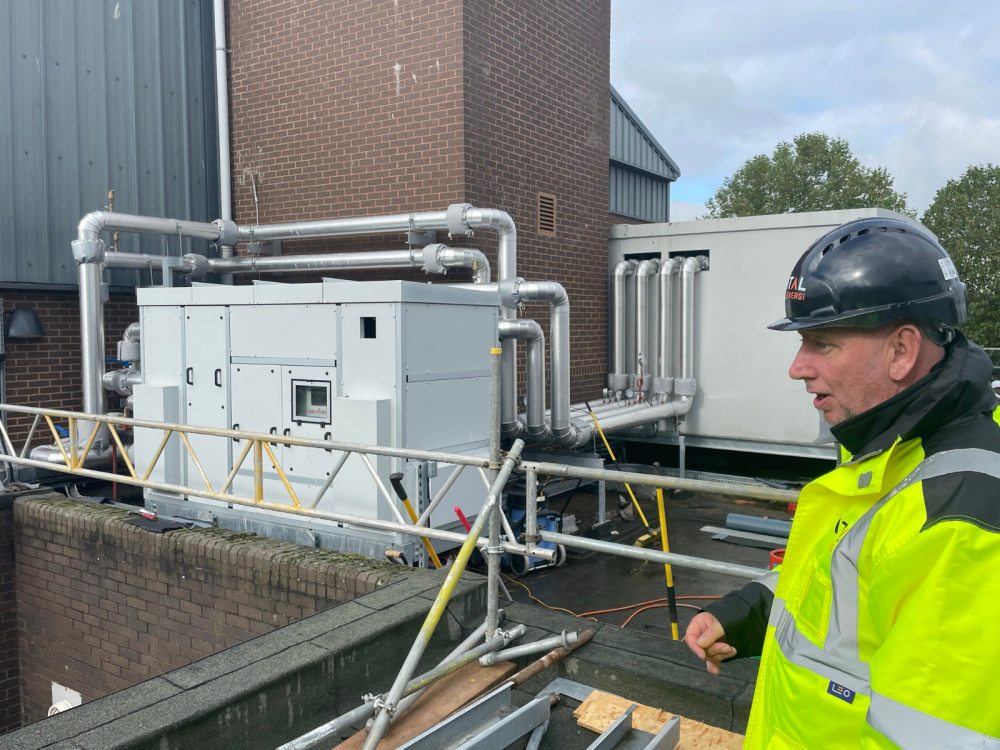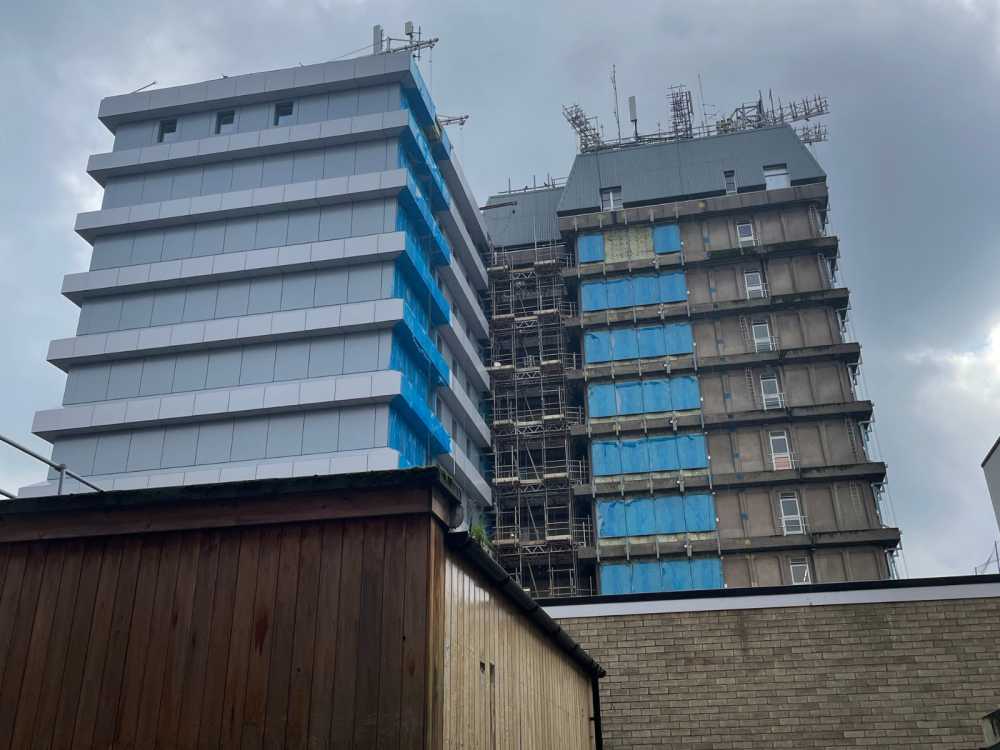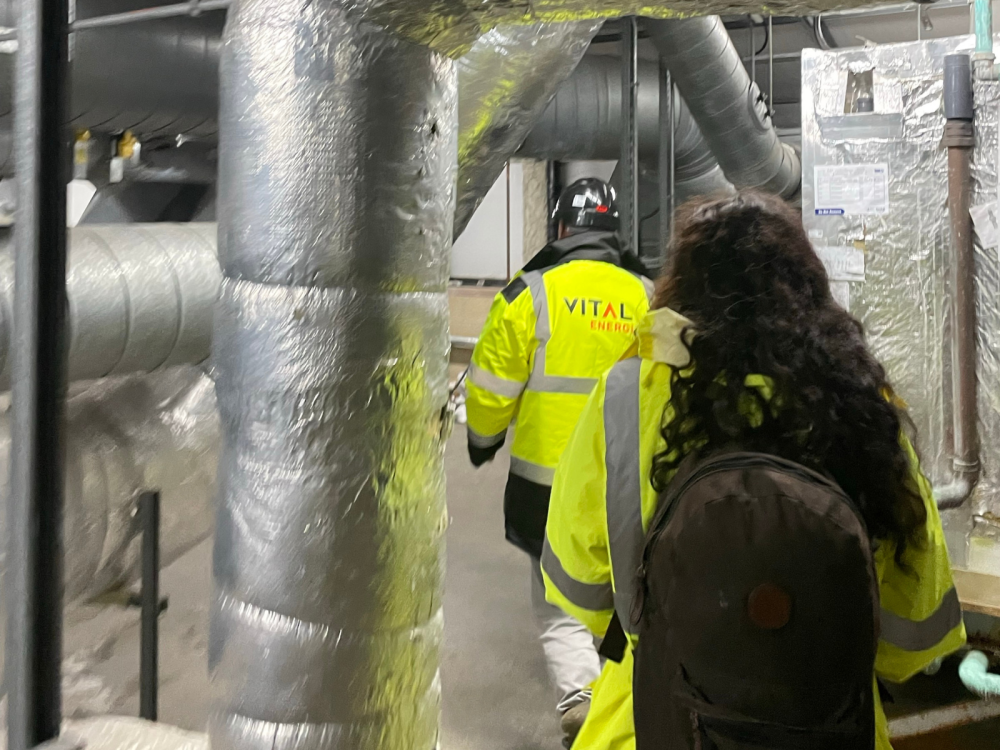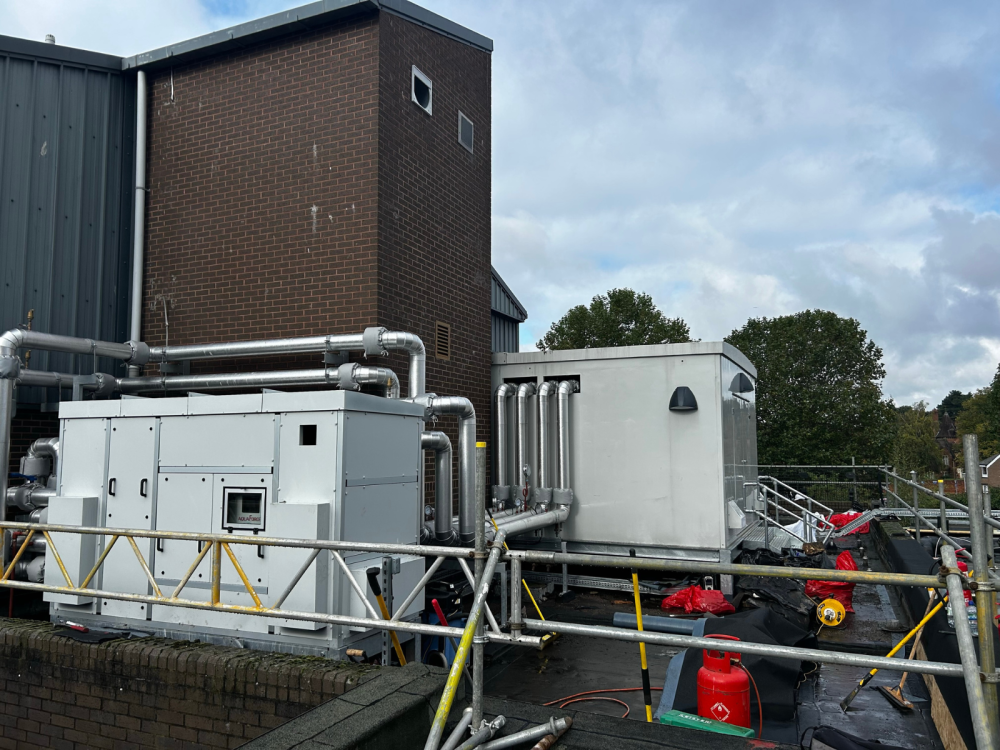Skyline transformed by Gloucester hospital green project

Patients and staff benefit from new look Gloucestershire Royal Hospital’s Tower Block
A 1970s hospital tower block, home to a protected peregrine falcon nest, has been transformed, thanks to government funding.
The 10 storey Gloucestershire Royal Hospital’s (GRH) Tower Block has benefited from the Public Sector Decarbonisation Scheme and has been turned into a modern, contemporary looking building which now transforms the city skyline.
Patients, visitors and staff will now benefit from the project – and even the protected falcons will be more comfortable as they nest.
The project is managed by Gloucestershire Managed Services (GMS), a wholly owned subsidiary of Gloucestershire Hospitals NHS Foundation Trust and was developed and delivered by Vital Energi, with support from the Carbon and Energy Fund (CEF) framework.
Our Salix team visited the site to take a first-hand look at the project and discuss some of the challenges faced during work.
During the day our team met Terry Hull, strategic assets director, and Alison Wilmshurst, energy manager, both from GMS, as well as senior project manager, David O’Dowd from Vital Energi.
Terry and Alison explained that the £10.9 million funding from the Public Sector Decarbonisation Scheme means the building is now more thermally efficient and comfortable for patients and staff.
And to ensure the scheme achieves its full potential the Trust also invested an additional £1.2m in capital funding, meaning a total funding package of £12.1m for the project.
This investment complements an existing capital programme of more than £100m enabling the Trust to transform Cheltenham and Gloucester acute hospital sites.
Terry said: “The aesthetic improvement is obvious as the tower can be seen from afar, but even more importantly the project will significantly reduce direct carbon emissions.
“Indeed, the Tower Block façade works are a very visible improvement to the estate, previously a gloomy 1970s concrete 10 storey tower, now enrobed in a two-tone light grey.”
The aesthetic improvement is obvious as the tower can be seen from afar, but even more importantly the project will significantly reduce direct carbon emissions.
However, the project has not been without its challenges especially when, after consultation with a peregrine specialist, the falcons could not be persuaded to move to a specially built nest.
The birds of prey are protected by law and with around 1,500 pairs in Britain, their nests must be treated with great care. Once the falcons have nested, they move to the nearby Gloucester Cathedral along with their chicks.
David said: “Project delivery was delayed 22 weeks due to nesting peregrines on the Tower Block, this was despite our best efforts to entice them into an alternative and much nicer nest.”
He also explained how there had been further distinct challenges related to working on a live hospital site where the primary concern is the care of patients.
Project delivery was delayed 22 weeks due to nesting peregrines on the Tower Block, this was despite our best efforts to entice them into an alternative and much nicer nest.
Terry added: “Of course, working in a hospital has very specific challenges and access to clinical areas to replace the windows has been challenging.
“Significant co-ordination with the Trust bed management teams has been required to maintain progress.”
During our visit we were able to view the plant rooms to see the 200kW air source heat pump funded under Phase 3a of the Public Sector Decarbonisation Scheme as well as the solar PV.
The heat pump will provide low carbon heat to the hospital with upgrades to the heating hot water control systems also taking place which will further reduce energy usage and carbon emissions.
Other works that were funded by this phase include insulating the kitchen and restaurant roof and the replacement of failed steam traps, which will eliminate wastage from the steam distribution system. All these projects are set to generate both carbon and financial savings, according to project leads.
Vital Energi have calculated that this work will see the Trust’s carbon footprint reduced by 1,389 tonnes a year while achieving energy efficiency savings in excess of £82,000 per year.
Alison said: “The building is now much more inviting and modern looking.
“Equally, the façade insulation and window replacements will ensure that the building is more comfortable for occupants with improved environmental conditions and control and will enable a level of natural ventilation with the incorporated window restrictors.
“Upgrading the building fabric will also help with mitigating the impacts of climate change, for example, reducing the risk of damp and mould due to wetter weather.”
Terry added the money saved from the project can now be redirected to refurbishing other parts of the hospital, rather than utility bills.
Terry said: “These projects have helped us to tackle some of the low hanging fruit, in terms of obvious energy projects that also generate a financial surplus. It’s now imperative that we develop a technical heat decarbonisation plan that will help us to move away from steam and highlight options for our CHP.”
These projects, quite simply, would not have taken place without the government funding delivered through Salix, but the benefits go beyond carbon reduction and financial savings, the works have also helped to replace outdated equipment, reduce patient risk of harm and ensure that a 50-year-old building can meet modern thermal requirements for patient comfort.
Salix client support officer Sophia-Bella said she was impressed by the scale of the works and the huge passion of the team involved in the works.
Sophia-Bella said: “This is an important project for the Trust as it will mean the hospital can provide a more comfortable environment throughout the building along with enabling the Trust's commitment to sustainability, cutting their reliance on fossil fuels and reducing energy costs in the long-term.
“Huge congratulations to the Trust on moving this project forward and making a difference.”
The Trust has declared a climate emergency and is working towards the NHS net zero target by 2040, with an interim goal of an 80% reduction by 2028-32.
After the visit Mike Gregson, managing director of GMS commented: “The projects delivered through Public Sector Decarbonisation Scheme have kick-started the carbon reduction journey and have demonstrated what we can achieve and enabled our progress towards the target.
“These projects, quite simply, would not have taken place without the government funding delivered through Salix, but the benefits go beyond carbon reduction and financial savings, the works have also helped to replace outdated equipment, reduce patient risk of harm and ensure that a 50-year-old building can meet modern thermal requirements for patient comfort.”
Steve Black account director at Vital Energi, added: “We’re proud to have delivered low-carbon solutions across the hospital estate as part of the second phase of Public Sector Decarbonisation Scheme works.
"Our comprehensive upgrades to the external fabric and windows of the Tower Block, from the ground floor to the 10th floor, have significantly reduced heat loss, which in turn will lower energy usage, reduce carbon emissions, and cut energy bills.
"These improvements are not only helping the Trust work towards its goal of net zero by 2040 but also creating a better environment for patients, staff, and visitors.”








